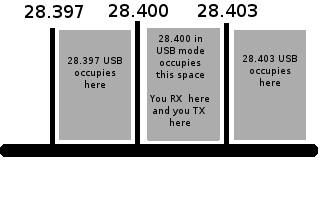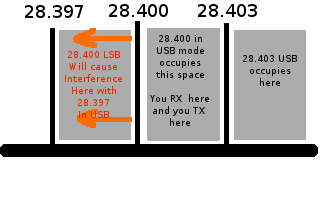Understanding the basics of SSB transmission Fundamentals of operating on single sideband
Some SSB transmitting fundamentals
For whatever reason there is always confusion over SSB operating. I noticed there weren’t very many articles around that did a decent job explaining what LSB and USB transmissions “look like” and too many operators just don’t understand why or how they are interfering with other stations or in the reverse, how to figure out which direction to go in to get away from another encroaching station.

To start with, let’s understand that your dial frequency is where your transmission pass band begins. So if you tune your radio to 28.400 MHz and you are operating in USB mode, a typical width your transmission will occupy is 3kHz. To the right you will see the tuned dial frequency and the indication of the space on the band that your transmission is occupying.
If anyone is within the space of your pass band, you will interfere with them and vice-versa.

The next point to understand is why there exist gentleman’s agreements as to which mode, USB or LSB is used for a given frequency range. If you stack transmissions next to each other, which is common when the bands are full of operators, it is necessary to keep 3kHz spacing between each ongoing conversation to ensure reasonable copy. By sticking to a common mode, you can more tightly stack these conversations in the spectrum.

To the right you will see the center frequency of 28.400 and a few others lined up at 3kHz intervals. Each one is in USB mode. The base frequency and the area +3kHz from that point are occupied for each ongoing conversation. If you have an operator come on the band and start to operate using LSB, their conversation will encroach to the ‘left’ going -3kHz. Meaning at 28.400 the conversation in USB actually covers up to 29.403, if it was in LSB it would go down to 28.397.
Normally in all USB operation operators would be at 28.397,28.400, 28.403 and they could all operate freely without interfering with each other. If an operator fires up on 28.400 in LSB, they will be interfering with the operators on 28.397. This makes the use of the band less efficient and more confusing if people mix the modes of operation.
When you are tuning around in SSB, ensure you are in the correct mode for the gentleman’s agreement that applies to the band you are operating on. If you hear any other signals as you are tuning, there are operators occupying that space in the spectrum. Either tune them in and join the conversation, or continue to spin the VFO until you no longer hear any interference. Otherwise you will be interfering with an ongoing QSO, which is plainly, bad operating practice.
Yet one more reminder, there is no such thing as working ‘on frequency’ when in SSB mode. There are no channel assignments, there is only spectrum space. If you are tuned into the zero beat frequency of another operator (if you are, their voice will sound perfectly natural), no matter what your dial is reading, you are both “on frequency”. You can be tuned to 28.3987, as long as you hear no other operators, you are clear to transmit. Any operator joining you should also tune by ear to match you. If you find there are operators at say 28.397, you will notice that you are clear of them in USB mode at 28.400, that is where you should then operate if you don’t want to join them.
This is pretty basic stuff, but a shocking number of amateur operators really have no understanding of these fundamental concepts. I hope this will help explain things clearly for those who are curious.
blog comments powered by Disqus